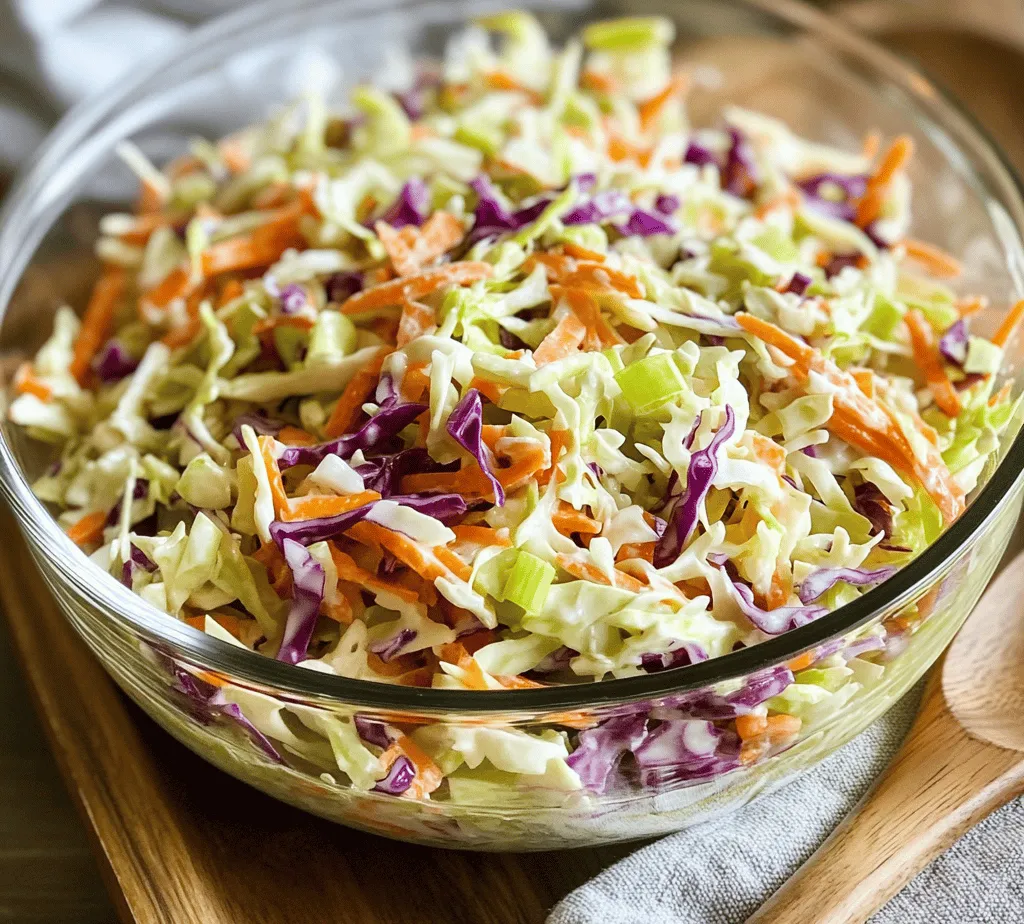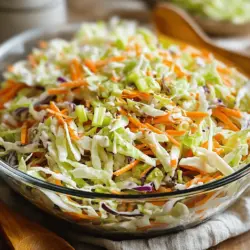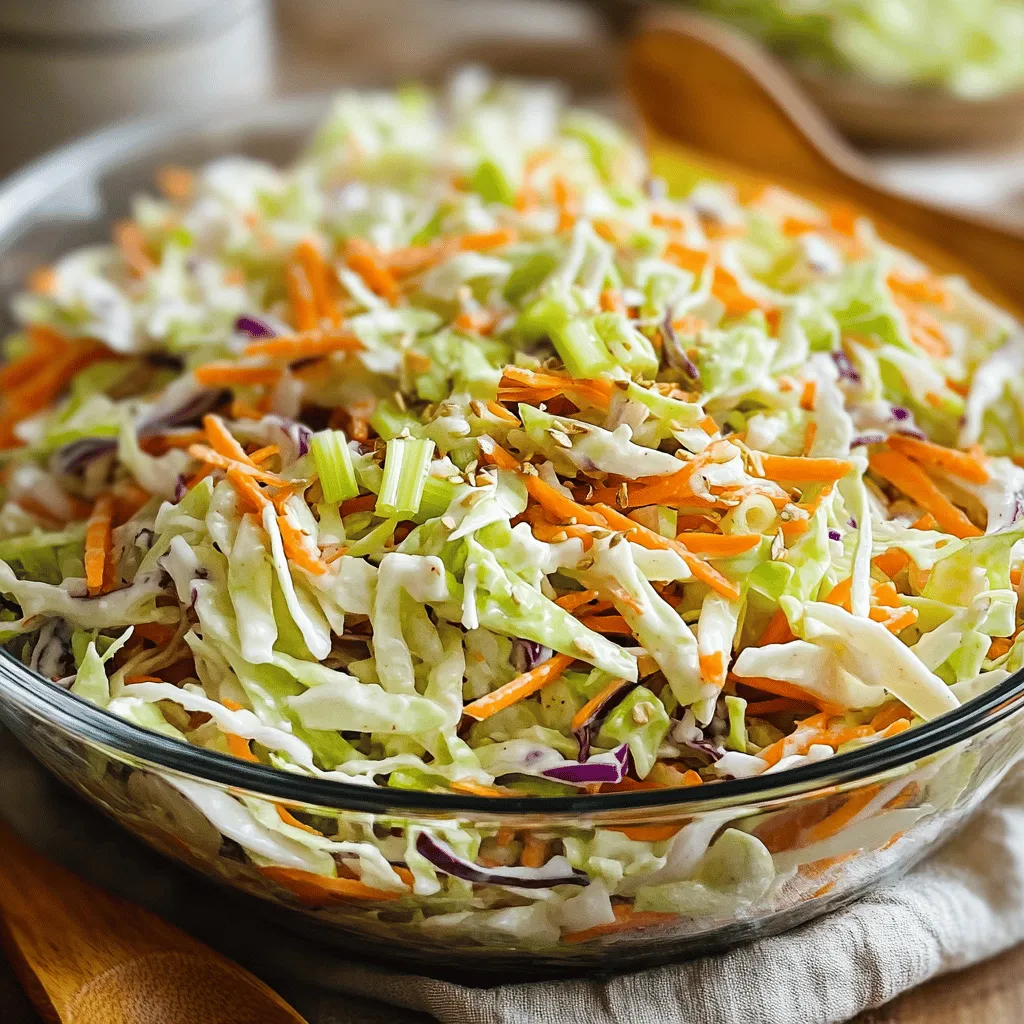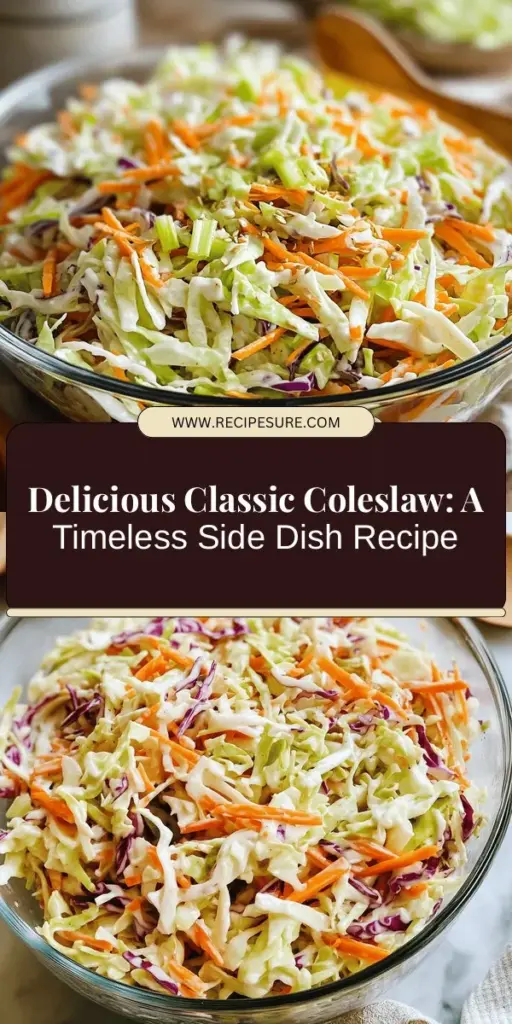Introduction
Coleslaw is a classic side dish that has been enjoyed for generations, offering a refreshing crunch that complements a wide array of meals. Traditionally made with finely shredded raw cabbage and dressed most commonly with a vinaigrette or mayonnaise, coleslaw has earned its place on the table at barbecues, picnics, and family gatherings. Its versatility allows it to fit seamlessly into various cuisines, making it a beloved staple across cultures.
Whether served alongside a hearty barbecue platter, as a topping for pulled pork sandwiches, or simply enjoyed on its own, coleslaw brings a delightful crunch and a burst of flavor to any dish. The classic coleslaw recipe stands out as a simple yet flavorful option that balances the crispness of vegetables with a creamy dressing, making it an accessible dish for cooks of all skill levels.
Understanding Coleslaw
Coleslaw has a rich history that dates back to ancient Rome, where a similar dish made from cabbage and eggs was enjoyed. However, the modern version of coleslaw as we know it today emerged in the 18th century in Europe, particularly in the Netherlands and France. The name “coleslaw” is derived from the Dutch term “koolsla,” which means “cabbage salad.” Over time, the dish made its way to the Americas, where it became a popular accompaniment to grilled meats and fried foods.
Culturally, coleslaw holds significance in various regions, often adapting to local tastes and ingredients. In the Southern United States, for example, coleslaw is frequently prepared with a sweeter dressing, while in other areas, a vinegar-based dressing is preferred. Each variation reflects the culinary preferences and available ingredients of the region, showcasing how coleslaw can be customized to suit diverse palates.
From a nutritional perspective, coleslaw is a beneficial addition to your diet. Cabbage, the primary ingredient, is low in calories and rich in vitamins C and K, while also providing fiber and antioxidants. The inclusion of carrots not only adds a pop of color but also boosts the dish’s nutritional profile with additional vitamins and minerals. Overall, coleslaw can be a healthy and satisfying side dish that contributes to a balanced diet.
Ingredients Breakdown
To create a classic coleslaw, you’ll need a selection of fresh ingredients that come together to form a vibrant and flavorful dish. Here’s a breakdown of the key components:
The Role of Cabbage
Green Cabbage: This is the most common variety used in coleslaw. With its crisp texture and mild flavor, green cabbage provides a sturdy base for the salad. It’s low in calories and high in vitamins C and K, making it a nutritious choice. The crunchiness of green cabbage adds a satisfying bite to the dish.
Red Cabbage: Often used in combination with green cabbage, red cabbage not only introduces a striking color contrast but also enhances the flavor profile with its slightly peppery taste. Rich in antioxidants, particularly anthocyanins, red cabbage offers additional health benefits, including improved heart health and anti-inflammatory properties.
Carrots
Carrots are an essential addition to classic coleslaw, contributing both sweetness and color. They are a great source of beta-carotene, which the body converts into vitamin A, essential for maintaining healthy vision and immune function. Their natural sweetness complements the savory elements of the dish, providing a delightful balance of flavors. The bright orange hues of carrots also make the coleslaw visually appealing, enticing diners to indulge.
Dressing Components
The dressing is pivotal in bringing the ingredients together, creating a cohesive flavor profile that elevates the entire dish. The classic coleslaw dressing typically includes the following components:
Mayonnaise: This creamy base is what gives coleslaw its signature texture. Mayonnaise provides a rich mouthfeel that coats the vegetables, enhancing their flavor while adding a satisfying creaminess. For a lighter option, consider using Greek yogurt as a substitute for mayonnaise while still achieving a creamy consistency.
Apple Cider Vinegar: Adding a tangy kick, apple cider vinegar brightens the overall flavor of the coleslaw. Beyond its taste, this vinegar is known for its potential health benefits, including aiding digestion and possibly regulating blood sugar levels. The acidity of the vinegar balances the richness of the mayonnaise, creating a harmonious dressing.
Dijon Mustard: A touch of Dijon mustard introduces a depth of flavor that enhances the dressing. Its slight spiciness and acidity help to cut through the creaminess of the mayonnaise, adding complexity to the overall taste of the coleslaw.
Honey (or Sugar): A hint of sweetness from honey or sugar is essential to balance the tang of the vinegar and the richness of the mayonnaise. Honey, in particular, can contribute a unique flavor dimension, making the dressing more nuanced.
Celery Seed: This often-overlooked ingredient provides a distinctive flavor that elevates the coleslaw. Celery seed has a warm, slightly nutty taste that complements the other ingredients and adds an aromatic quality to the dish.
The Role of Salt and Black Pepper: Finally, seasoning with salt and black pepper is crucial for enhancing the overall flavors of the coleslaw. Salt helps to bring out the natural flavors of the vegetables, while black pepper adds a subtle heat that rounds out the dish.
With these ingredients, you’re well on your way to creating a classic coleslaw that is not only delicious but also offers a refreshing crunch and vibrant flavors. The combination of textures and tastes makes this dish a favorite among many, and it’s easy to see why it remains a staple at gatherings and meals across the globe.
In the next part of the article, we will delve into the step-by-step instructions on how to prepare this classic coleslaw, ensuring you can recreate this timeless dish in your own kitchen. Stay tuned for tips on achieving the perfect blend of flavors and textures!

Step-by-Step Instructions for Classic Coleslaw
Creating the perfect classic coleslaw is all about the balance of textures and flavors. Here’s a detailed guide to get you from start to finish.
Step 1: Prepare the Vegetables
Start by choosing fresh, crisp vegetables. For classic coleslaw, you’ll need green cabbage, carrots, and optional ingredients like red cabbage or bell peppers for added color.
- Cabbage: Remove the outer leaves of the cabbage and cut it into quarters. Remove the core and slice the cabbage into thin shreds. The finer the shreds, the better they will mix with the dressing.
- Carrots: Peel the carrots and grate them using a box grater or a food processor. Aim for uniform pieces to ensure even distribution in the slaw.
- Optional Ingredients: If you choose to add red cabbage for color, slice it thinly just as you did with the green cabbage. You might also want to include shredded bell peppers for a sweet crunch.
Step 2: Mix the Dressing
The dressing is crucial for flavor, and it’s where you can customize your coleslaw.
- Base Ingredients: In a large mixing bowl, combine mayonnaise, apple cider vinegar, sugar, salt, and pepper. For a light tang, you can also add a teaspoon of Dijon mustard.
- Whisk Together: Use a whisk to blend the dressing until smooth. Taste and adjust seasoning as necessary; you may prefer a slightly sweeter or tangier taste.
Step 3: Combine the Vegetables and Dressing
Once your vegetables are prepared and the dressing is ready, it’s time to bring everything together.
- Mixing: Add the shredded cabbage and grated carrots to the bowl with the dressing. Using tongs or a large spoon, gently toss the vegetables with the dressing until they are fully coated. Ensure that all the cabbage and carrots are well mixed and that no dry pieces remain.
Step 4: Taste and Adjust
This is a crucial step in achieving the perfect coleslaw.
- Flavor Balance: After mixing, taste your coleslaw. If it feels too tangy, you may want to add a touch more sugar. If it feels too bland, a pinch of salt or an extra splash of vinegar can enhance the flavor. Adjust according to your personal preference.
Resting Time: Why It Matters
Resting your coleslaw is not just a suggestion; it’s essential for optimal flavor and texture.
- Flavor Meld: Allowing the coleslaw to sit for at least 30 minutes before serving helps the flavors meld together. The vinegar in the dressing begins to break down the cabbage, which enhances the overall taste.
- Refrigeration: If time allows, refrigerate your coleslaw for a couple of hours (or even overnight). This allows the ingredients to marinate and infuse the dressing deeply into the vegetables.
- Timing Variations: For a crunchier texture, serve the coleslaw sooner after mixing. For a softer, more infused flavor, let it rest longer. Adjust the resting time based on your desired flavor profile.
Serving Suggestions
Coleslaw is a versatile side dish that complements a variety of meals and occasions.
- Ideal Occasions: Classic coleslaw is perfect for summer barbecues, picnics in the park, and family gatherings. It’s also a great addition to potlucks and holiday celebrations.
- Pairing with Main Dishes: Serve coleslaw alongside grilled meats like barbecued ribs, chicken, or burgers. It also pairs wonderfully with fried foods and sandwiches, adding a refreshing crunch.
- Creative Serving Ideas: Get creative by serving coleslaw in wraps, tacos, or as a topping for sandwiches. You can also add toppings such as sunflower seeds, nuts, or freshly chopped herbs for an extra layer of flavor.
Nutritional Analysis
Understanding the nutritional value of your coleslaw can help you make informed dietary choices.
- Nutritional Breakdown: A typical serving of classic coleslaw (about 1 cup) contains approximately 150-200 calories, depending on the amount of mayonnaise used. It generally includes around 10-15 grams of fat, mostly from the mayonnaise, and about 5-10 grams of carbohydrates.
- Health Benefits: Cabbage and carrots are both nutrient-dense vegetables. They are low in calories but high in vitamins C and K, fiber, and antioxidants. Raw vegetables can aid digestion and improve overall gut health.
- Dietary Preferences: Classic coleslaw is naturally vegetarian and can easily be made gluten-free. For those following a vegan diet, simply substitute regular mayonnaise with a plant-based alternative.
Common Questions About Coleslaw
Here are answers to frequently asked questions about storing and preparing coleslaw.
- How to Store Coleslaw for Optimal Freshness: Coleslaw can be stored in an airtight container in the refrigerator for up to three days. However, it’s best consumed within the first day or two for the freshest flavor and crunch.
- Can Coleslaw Be Made in Advance?: Yes, coleslaw can be made in advance. In fact, many find that the flavor improves after sitting for a while. Just be mindful of the texture; if you let it sit too long, it may become soggy.
- Substitutions for Common Ingredients: If you’re looking for alternatives, vegan mayonnaise works well for a plant-based version. For sweetness, consider alternative sweeteners like honey or agave syrup. You can also experiment with different types of vinegar for varied flavor profiles.
Conclusion
Classic coleslaw is a delightful dish that’s both versatile and easy to prepare. With its crisp textures and tangy dressing, it’s a staple side that can elevate any meal. Whether you stick to the traditional recipe or experiment with your own variations, the possibilities are endless. Encourage yourself to try new ingredients and flavors; who knows, you might just create your new favorite coleslaw recipe! Embrace the enduring appeal of this classic dish and share it with friends and family at your next gathering.


